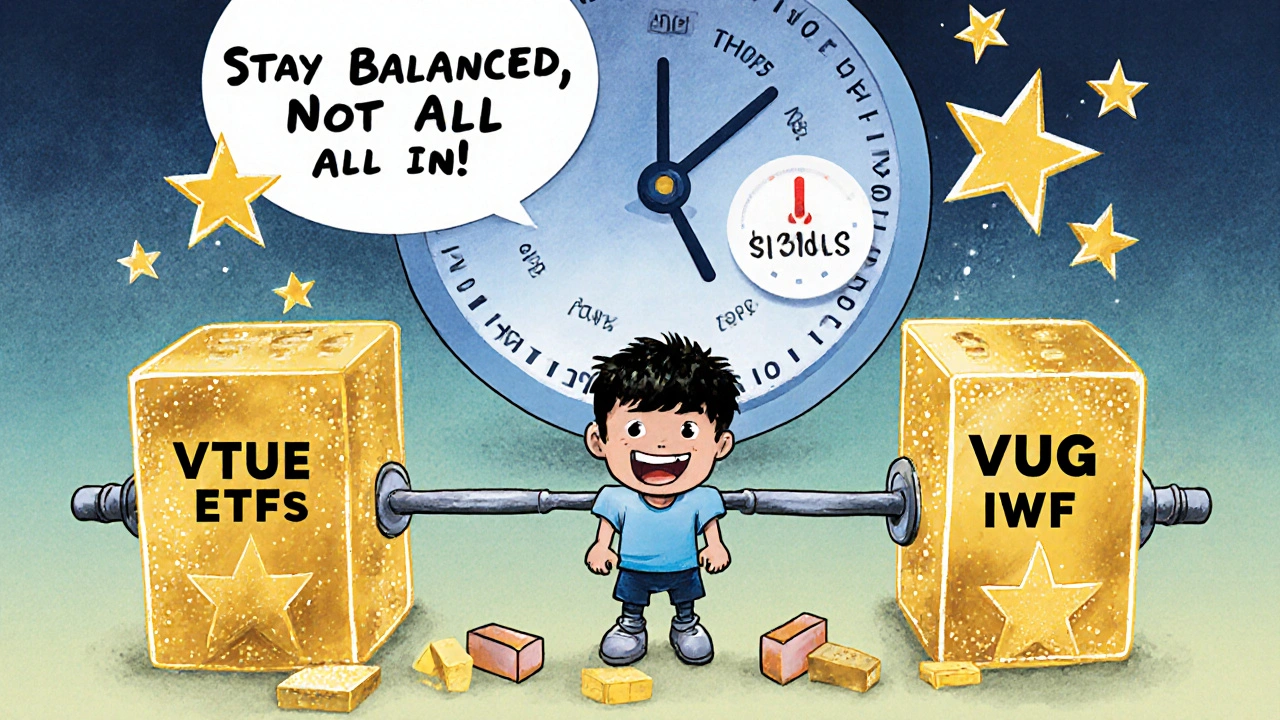Style Rotation Calculator
Optimize your portfolio allocation based on key market signals. This tool helps you determine the right balance between value and growth stocks using historical market data.
ISM PMI (35-65)
Economic expansion signal. Above 55 indicates strong economy favorable for value stocks.
S&P 500 vs 200-Day MA
Market trend indicator. Negative values indicate weakening market (favoring value).
Value Spread (P/E Ratio)
Value stocks trading at deeper discount than historical averages.
Inflation & Rates
Higher inflation/federal rates favor value stocks.
For years, growth stocks dominated. Tech giants, flashy startups, companies with no profits but big dreams-they were the stars of the market. But something changed in 2022, and it’s still unfolding. Value stocks-cheaper, dividend-paying, often overlooked companies-are making a comeback. This isn’t just a short-term bounce. It’s a style rotation-a shift in what’s working in the market. And if you’re still holding only growth stocks, or worse, chasing them after they’ve already run up, you’re leaving money on the table.
What Is Style Rotation, Really?
Style rotation means moving your money between two broad types of stocks: value and growth. It’s not about picking individual winners. It’s about recognizing which style is in favor based on the economy, interest rates, and how expensive stocks are relative to each other. Value stocks are cheap. They trade at low prices compared to their earnings, book value, or cash flow. Think banks, energy companies, industrial manufacturers. These are businesses that are profitable now, not just hoping to be someday. Growth stocks are expensive. They trade at high prices because investors expect big future earnings. Think AI startups, cloud software firms, electric vehicle makers. Their value is in what they might become, not what they are today. The key insight? These two styles don’t perform the same way all the time. They take turns. When the economy is strong and inflation is rising, value usually wins. When money is cheap and growth feels guaranteed, growth dominates.Why Value Is Outperforming Again (And Why It Matters)
From 2009 to 2021, growth crushed value. The Russell 1000 Growth index returned 187% more than the Value index over that stretch. That’s not a small edge-that’s a generational trend. But since early 2022, things flipped. Value outperformed growth by over 8% in 2022 alone. By April 2025, value had started to lead in international markets for the first time since the early 2000s. Why now? Three big reasons:- Higher interest rates: Growth stocks rely on future cash flows. When rates rise, those future dollars are worth less today. Value stocks, with their current profits, aren’t as sensitive.
- Inflation: Companies that can raise prices-like energy firms or banks-do better when inflation is high. Growth companies often can’t pass on costs as easily.
- Valuation gap: At its peak, growth stocks were trading at nearly double the price-to-earnings ratio of value stocks. That gap has narrowed, but it’s still wide enough to suggest room for more rotation.
How to Know When to Rotate
You can’t just guess. You need signals. Here’s what works:- Check the ISM PMI: If it’s above 55, the economy is expanding fast. That’s good for value stocks.
- Watch the S&P 500’s 200-day moving average: If the market is trending up, growth usually leads. If it’s flat or falling, value often gains ground.
- Measure the value spread: Look at the P/E ratio difference between the Russell 1000 Value and Growth indexes. When value is trading at a deeper discount than normal, it’s often a sign it’s about to rebound.
- Track inflation and Fed policy: Rising inflation and rate hikes favor value. Falling inflation and rate cuts favor growth.

Where to Find Value and Growth Stocks
You don’t need to pick individual stocks. ETFs make this easy.- For value: VTV (Vanguard Value ETF), IVE (iShares Russell 1000 Value ETF), or EFAV (iShares MSCI EAFE Value ETF) for international exposure.
- For growth: VUG (Vanguard Growth ETF), IWF (iShares Russell 1000 Growth ETF), or EFG (iShares MSCI EAFE Growth ETF).
The Big Risk: Timing It Wrong
Style rotation sounds simple. But it’s one of the hardest things to do well. The biggest mistake? Chasing performance. If you sell your growth stocks after they’ve dropped 20%, you’re likely selling low. And if you buy value after it’s already up 15%, you’re buying high. Another trap: thinking this rotation is permanent. The 2000s saw a value boom after the dot-com crash. Then growth came roaring back for 20 years. This time could be different-but it might not be. Columbia Threadneedle’s research shows that missing just the 10 best market days over 20 years can slash your returns by half. If you’re constantly switching between styles, you risk being out of the market during those spikes.A Better Way: The Barbell Approach
You don’t have to choose one or the other. Many institutional investors now use a barbell strategy: keep a core holding in both value and growth, then tilt your portfolio based on signals. For example:- 60% in a balanced index fund (like VTI)
- 20% in a value ETF
- 20% in a growth ETF

Who’s Doing This Right?
Large institutions are leading the way. 68% of institutional investors now use style rotation, up from 42% in 2020. Endowments and pension funds use it in 70-85% of their portfolios. Retail investors? Only 28% do. Why? Because it takes discipline. You need to track economic data. You need to ignore headlines. You need to stick to your plan when everyone else is panicking or euphoric. Firms like AQR and Research Affiliates have built entire strategies around this. Even traditional managers like Baird Asset Management use an RVR system-ranking stocks by Revenue growth, Valuation, and Return on capital-to make gradual shifts, not sudden jumps.What’s Next?
As of mid-2025, growth has outperformed value by 37.6% since January 2023. Historically, value tends to bounce back after a 50%+ gap. We’re not there yet-but we’re getting close. WisdomTree believes this is more than a cycle. They see structural changes: tighter monetary policy, steeper yield curves, and a global shift away from ultra-low rates. That could mean value stays in favor longer than expected. But Columbia Threadneedle warns: post-pandemic markets are unpredictable. The old rules might not apply. And with passive investing now making up nearly half of the U.S. market, the way stocks move could be changing too.Bottom Line
Style rotation isn’t magic. It’s math. It’s history. It’s patience. If you’re still holding only growth stocks because ‘that’s what works,’ you’re ignoring the last 150 years of market cycles. If you’ve sold everything and gone all-in on value because it’s up this month, you’re chasing a trend that could reverse. The smart move? Stay balanced. Learn the signals. Rotate slowly. And never forget: the market doesn’t care what you think. It only cares what it does.What’s the difference between value and growth stocks?
Value stocks are companies trading at low prices relative to their earnings, assets, or cash flow-think banks, energy firms, and manufacturers. They’re profitable now. Growth stocks are companies expected to grow earnings rapidly in the future-like tech or biotech firms. They often don’t make profits yet, but investors bet on big future gains. Value is about today’s value; growth is about tomorrow’s potential.
When should I rotate from growth to value?
Rotate when three of these four signals align: 1) ISM PMI is above 55 (strong economy), 2) the S&P 500 is below its 200-day moving average (market weakening), 3) the value-to-growth P/E discount is wider than historical averages, and 4) inflation is rising or interest rates are increasing. Don’t wait until value is already up 10%-that’s when most investors buy, and it’s often too late.
Can I use ETFs for style rotation?
Yes. ETFs are the easiest way. For value, use VTV or IVE. For growth, use VUG or IWF. For international exposure, try EFAV (value) or EFG (growth). These funds track broad indexes, so you’re not picking individual stocks-you’re betting on the style itself. They’re low-cost, liquid, and perfect for rotating between market phases.
Why did growth dominate for so long?
From 2009 to 2021, interest rates were near zero, inflation was low, and tech innovation exploded. Growth stocks thrived because cheap money made future earnings worth more. Companies like Apple, Amazon, and Microsoft delivered consistent results, and investors rewarded them with sky-high valuations. That period, called the ‘Great Growth Regime,’ was an outlier-growth outperformed value by 444% over that time. It’s not normal. It was a perfect storm.
Is style rotation risky?
Yes. The biggest risk is timing. If you rotate too early, you miss out on growth momentum. If you rotate too late, you buy high. Also, markets can stay irrational longer than you can stay solvent. Missing just the 10 best days in 20 years can cut your returns in half. That’s why many investors use a barbell approach-keeping core exposure to both styles and adjusting gradually, not all at once.




This is the most coherent, data-backed breakdown of style rotation I've seen in years. The ISM PMI + 200-day MA + value spread combo is gold. I’ve been rotating into VTV since Q4 last year after seeing all three signals align - and yeah, I didn’t wait for the 10% pop. Bought when it was still languishing at 18x P/E. Now it’s at 21.5, but I’m not panicking. The Fed’s not done hiking, and inflation’s still sticky. This isn’t a bounce - it’s a regime shift.
Also, the barbell approach? Absolute genius. I’ve got 60% VTI, 20% VTV, 20% VUG. Keeps me sane when the tech boys are screaming about AGI. No emotional whiplash. Just math. The market doesn’t care what you feel. It cares what you do.
And yes - 68% of institutions are doing this. We’re not outliers. We’re just the ones who read the footnotes.
It is truly fascinating, isn't it, how the pendulum of human greed and fear swings across decades, only to return to the same quiet truths we once knew? Value stocks - those unglamorous, dividend-paying giants - they are not flashy, they do not tweet in emojis, they do not promise to change the world with blockchain or AI. But they pay dividends. They have balance sheets. They have cash flow. And in times of uncertainty, when the future feels like a foggy road, it is not the dreamers who survive - but those who hold tangible things, who earn today, not tomorrow.
And yet, we are taught, from childhood, to chase the shiny. To believe that growth is virtue. That innovation is morality. But history whispers otherwise. The dot-com crash. The 2008 collapse. Even the 1970s stagflation. Each time, the quiet ones endured. The loud ones vanished.
So perhaps this is not a rotation - but a return. A correction not of price, but of perception. We are remembering, slowly, painfully, that markets are not about hope - they are about numbers. And numbers do not lie.
Thank you for reminding us of this. In a world of noise, your words are a lighthouse.
Bro, the value spread is the single most underused indicator in retail investing. Everyone’s chasing meme stocks or AI ETFs, but nobody’s looking at the P/E delta between IVE and IWF. It’s like watching a football game and only cheering for the quarterback - you’re missing the whole damn offensive line.
And yeah, the barbell strategy? That’s the move. Core + tactical tilt. No need to go all-in or bail. Just adjust weights like you’re tuning a stereo. VTV at 25%, VUG at 15% when rates are climbing. Flip it when the Fed drops a dovish hint. Easy.
Also, EFAV for international? Yes. Europe’s value stocks are dirt cheap right now. German industrials, UK banks - trading at 8x earnings. That’s not a value play. That’s a robbery. And nobody’s buying. Classic.
Oh wow. Another ‘value is back’ think piece from someone who still uses Yahoo Finance and thinks ‘P/E ratio’ is a new crypto coin.
Let me guess - you also believe the Fed is ‘hiking to fight inflation’ and not just propping up zombie banks? And that ‘style rotation’ is some deep insight, not just the market finally realizing growth stocks were overpriced by 300%?
Here’s the truth: passive investing killed alpha. ETFs are just automated momentum machines. The ‘value’ rebound isn’t smart investing - it’s a liquidity squeeze. Everyone’s dumping tech to pay margin calls. That’s not a rotation. That’s a fire sale.
And you think 68% of institutions are ‘doing this right’? Most of them are just mimicking AQR’s 2018 model because their CIO doesn’t understand regression analysis. You’re not a strategist. You’re a trend follower with a spreadsheet.
Also, ‘barbell approach’? Cute. Sounds like something a hedge fund intern calls ‘portfolio optimization’ after watching a 12-minute YouTube video. Real alpha doesn’t come from ETFs. It comes from shorting overvalued tech and going long distressed energy names with insider ownership. But sure - keep buying VTV. It’s safer than your 401(k).
This is really helpful. 😊 I didn't know about the value spread. Will check VTV and IVE now.